
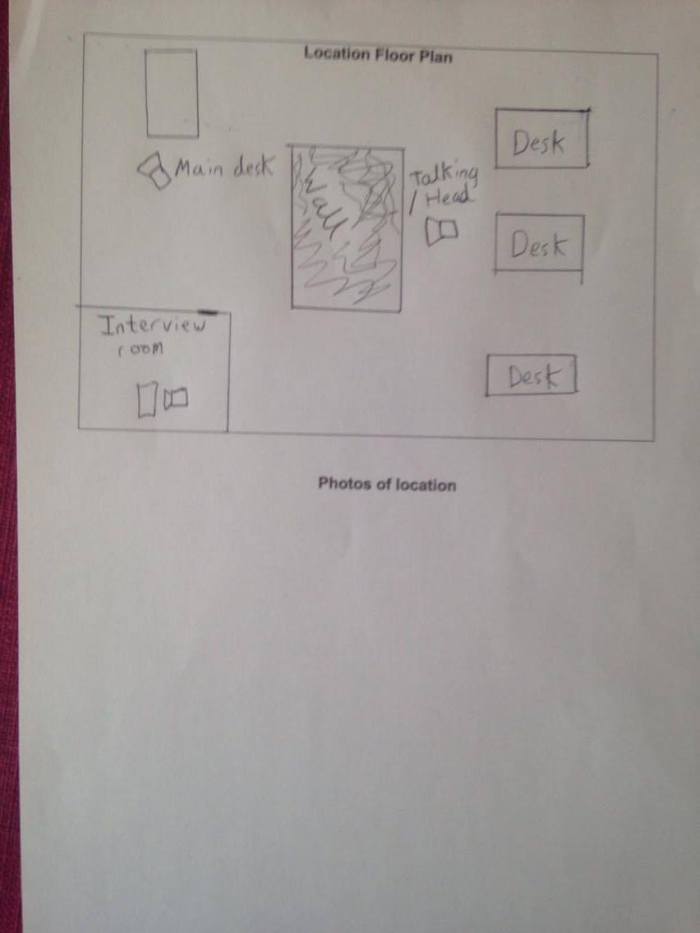 (photo will be added when I get it off my micro-SD)
(photo will be added when I get it off my micro-SD)
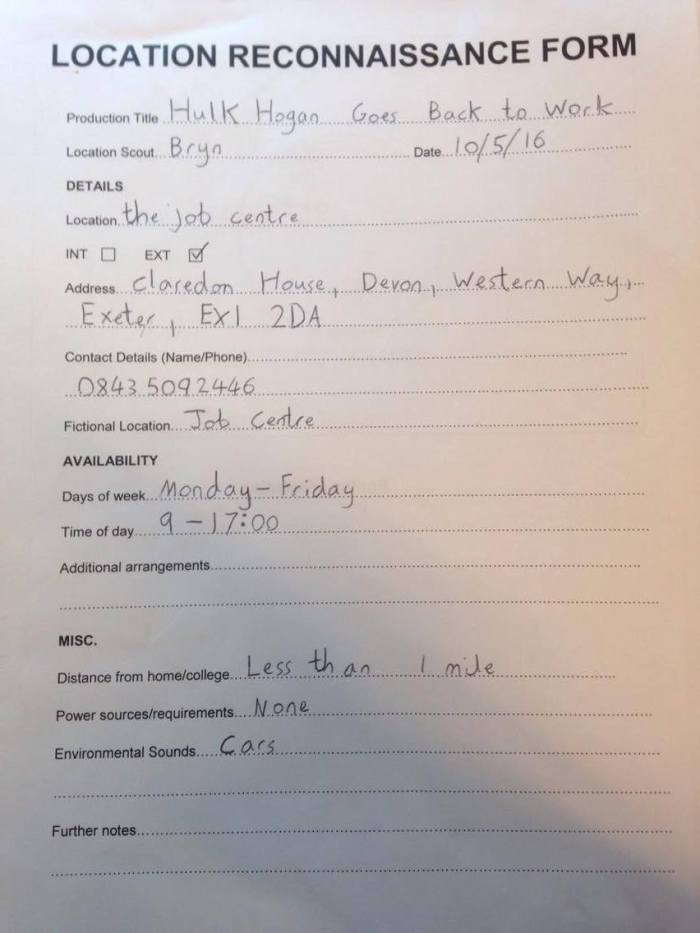


 (photo will be added when I get it off my micro-SD)
(photo will be added when I get it off my micro-SD)


My complete storyboard with details on shot types, audio and scene length:



I conducted research into my audience, media similar to my film’s genre, various filming techniques and other styles I could incorporate.
I created a survey to see how familiar the themes in my film were to my target audience. I gathered both qualitative and quantitative data in these areas. My survey gathered quantitative data such as age and gender demographics, and whether or not they liked The Office TV show and knew of Hulk Hogan. In that survey I also asked what their favorite comedy film or TV show was. I then followed up on this by doing a focus group on someone who both knew Hulk Hogan and said The Office was their favorite comedy.
This research was somewhat useful. Almost everyone I surveyed had seen The Office or at least heard of it, and many even had it as their favorite. This shows that my target audience was familiar with the mockumentary genre and I wouldn’t have to spend any time in the film establishing it. On the other hand, many people did not recognise Hulk Hogan, reinforcing my belief that archive footage would be necessary to introduce him. In that way, the research will make an impact on my film, but it didn’t reveal much more than I had expected.
Case Studies:
I researched three different media products similar in theme to mine. I chose to look at The Office, Wrestling Isn’t Wrestling and Parks and Recreation. This research helped me find my own target audience by comparing it to the audience for each of these products. Both mockumentaries I studied were genre defining and I learnt a lot by studying them. Max Landis’ Wrestling Isn’t Wrestling also presented methods of presenting wrestling characters to a mainstream audience.
Technical:
I had the idea of using green screen in my film, so I decided to look at how I might go about doing that, and experimented using it myself. This research was valuable as it developed a skill that I will undoubtedly use in the future, but I decided against using it here.
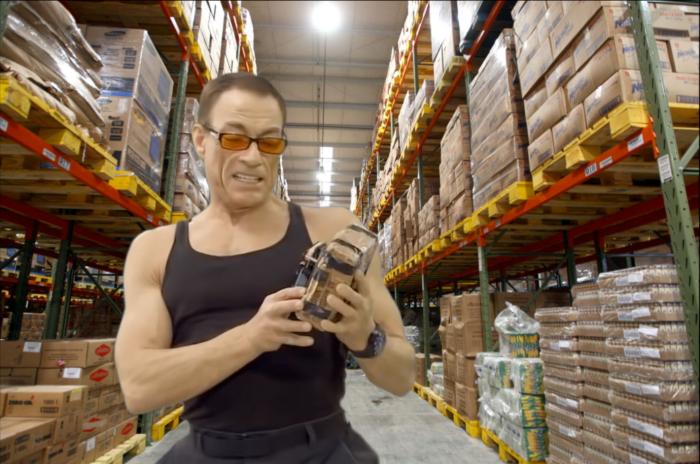
I looked up a few tutorials for using green screen and downloaded some assets off of YouTube. I used the keyer effect on the footage to make it overlay a simple background I found on google. With this, I made a simple, funny video with almost no effort at all. Now that I’ve developed this skill, I know I could do the exact same process in my FMP film easily. I uploaded the video here.


Sources:
-https://www.youtube.com/watch?v=iUo5WA-T01s
-https://www.youtube.com/watch?v=ObQLzAoXr-o
Type of Media Product / Film Title / Length of Media:
I’m planning to make a short mockumentary film with a run time of five to six minutes. The working title right now is simply: Hulk Hogan Goes Back to Work.
Logline:
After retiring from professional wrestling, Hulk Hogan has to reintegrate into the working world. Inspired by mockumentaries such as The Office, we’ll be following around Hogan as he struggles to deal with everyday life.
Synopsis:
Hulk Hogan goes to Job Centre Plus to get himself a new career. After several job interviews where his employers turn him away after hearing his ridiculous credentials including winning a fight with a shark, he finally gets hired working in an office. The cameras follow around Hogan as he struggles in the new environment and keeps getting flashbacks to his pro-wrestling days and hilarity ensues.
Characters:
Obviously my main character is Hulk Hogan, played by my friend Joel. I don’t know anyone who looks like Hulk of course, but so long as he has the signature mustache, bandanna and sunglasses, he should make for a good enough likeness.
Other minor characters would include interviewers and office workers which would either be just be in the background or have very few lines. I have quite a few people available to play these characters. At one point in the film, Hogan’s old tag partner: Randy ‘Macho Man’ Savage makes an appearance to try help him in his new life. He will also need a bandanna and sunglasses at least, and I’ll use archive footage to introduce him to the audience.
Locations:
For talking head segments with the characters, I will be using the white screen room in the TV studio as it provides a nice backdrop and I can have control over the lighting. I’ll also have a shot outside the Job Centre, showing Hogan going in all embarrassed. Most of the film will take place in the exams office down in the Tower Building, I scouted out the location last week and if I should be able to film in there.
Audience:
Although I’ll be making my film accessible to non wrestling fans, my core audience will probably have an interest in wrestling. My secondary viewership will come from fans of comedy shows such as The Office and Parks and Recreation as I hope to recreate their mockumentary style. The general audience for Parks and Rec was 16 – 24 year old men, which I’m choosing to target too as I think that demographic would be interested in my film. My survey and focus groups also showed that people in this age range were amused by my film idea.
Budget:
The only things I should have to spend money on is outfits and accessories. The generic office workers can just wear button up shirts which I shouldn’t have to buy loads of. For Hogan I’ll need his signature attire, although I won’t need his shirt or anything because he’ll be working in the office too. To get an ensemble together it would set me back about 15 to 20 pounds. As all my locations are local I won’t have to pay anything for transport.
Funding:
I’ll be self-funding as I don’t need much money.
As many of the people I interviewed said they liked Parks and Recreation (a lot had it as their favorite comedy), I decided to do my third case study on it. Parks and Recreation (2009) is an ongoing mockumentary sitcom starring Amy Poehler as Leslie Knope, a government deputy director trying to make a difference while surrounded by uncaring employees and officials. Similar to The Office, the series focuses on the relationships between the characters and their development. Parks and Rec has been described as “cute where The Office is awkward. Unlike The Office, the cast is full of well known, established actors which creates a more individual feel to every character as they express themselves via talking head segments (another Office trope) and go through their own story arcs.
From a technical and aesthetic standpoint, the show is shot similarly to The Office, following the characters around with cameras as they occasionally draw attention to this with nervous glances and surprised looks. They also make use of talking heads, but take the technique further than The Office did. As the show progresses, these segments become a vehicle used not only to tell and advance jokes, but as a window into the emotions of the characters. The lead character of Leslie Knope is the main focus for the first few episodes, but as more are introduced, you get to watch all their stories.
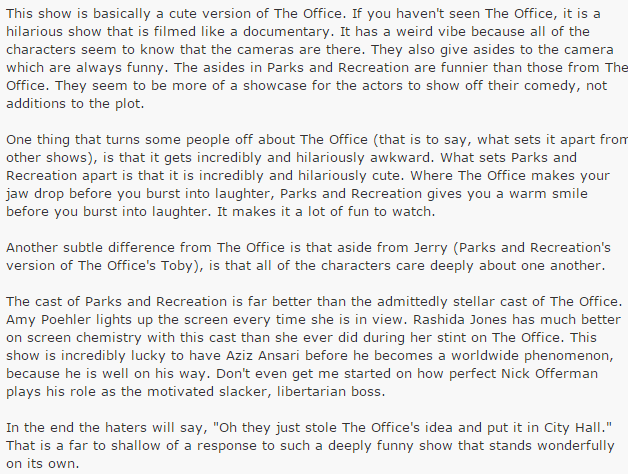
I compared the audiences of Parks and Rec with that of The Office and found that the average viewer was younger, but shared many traits of an older Office fan:
This perfectly matches my own target audience and means that my chosen style will appeal to them. I also noted that Parks and Rec has a higher viewership from women, perhaps due to the female lead character. I believe in representation in media, and realised that I only have male characters in my film, so I’ll try to expand beyond that.
Sources:
-http://www.imdb.com/title/tt1266020/
-https://en.wikipedia.org/wiki/Parks_and_Recreation
-https://yougov.co.uk/profileslite#/Parks_and_Recreation/demographics
-https://reelchange.net/2012/09/17/why-parks-and-recreation-matters/
I followed up on my survey with a focus group of people that responded positively to my questions (people that enjoyed The Office and recognised Hulk Hogan). Using this format, I could further analyse their sense of humor and how I could appeal to it.
I talked to four people and asked them why they found The Office funny. Their responses can be condensed into the following points:
-Compelling characters
-Satire comedy
-Realistic, relateable scenarios
I found this exercise very useful as I found it hard previously to describe why I liked mockumentaries. I asked the group if they liked my idea, and all of them were positive and thought it was funny even at face value.
Target Audience:
My core audience would be wrestling fans. Using YouGov Profiler, I discovered that the average age of these fans is in the 25-39 bracket. 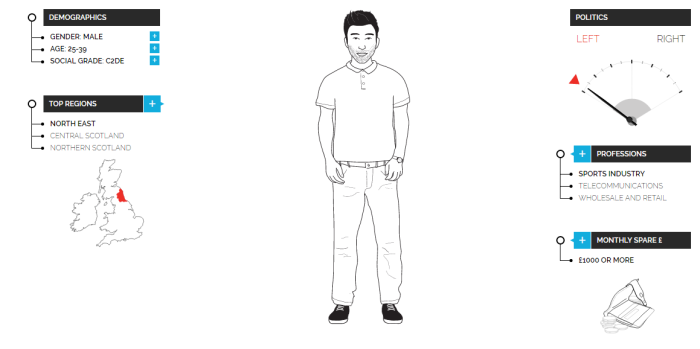
My audience will primarily be similar to this, although I’d target a slightly younger audience, from 16 to 25. Although I’m trying to appeal to people in that age regardless of whether or not they’re fans of wrestling, wrestling fans will become my core audience simply because of the nature of my film. Some people will decide that the film isn’t for them due to the wrestling content, even though being a fan won’t be crucial to understanding it and finding it funny.
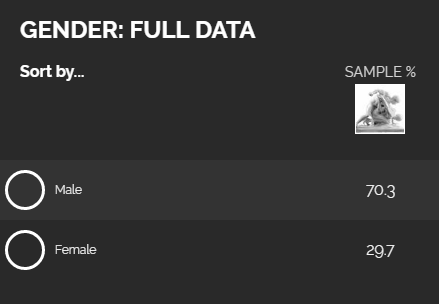
My secondary audience will be fans of comedy, especially the mockumentary format. In my case study of The Office, I discovered that the average audience is 40 to 54 year old men. This wasn’t the audience I expected, but after conducting my own survey on people in my targeted demographic, I discovered that almost all of them had seen and enjoyed The Office. Because of this statistic, I believe that my film will appeal to my audience. In my survey I also asked people whether or not they knew who Hulk Hogan was. To my surprise, the answers were split down the middle. For people that don’t know him, I hope my brief intro with archive footage will suffice and quickly bring them up to speed without boring them on a subject they don’t care for.

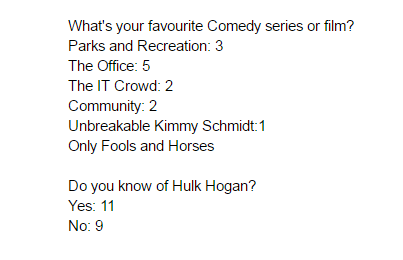
I typed up the results of my survey. It’s primary purpose was to gauge how many people were familiar with The Office and Hulk Hogan, and ask them what comedies they enjoyed to see what else I could draw inspiration from. From the people that responded positively to my survey, I created a focus group to ask further questions about why this type of comedy appealed to them.
I used this article to further research techniques that I could utilise to make my mockumentary seem more authentic. In particular, I looked at camera work. Handheld cameras were the way to go as they’d give it a less scripted aesthetic. I tested some of the shots in the locations I needed such as outside the Job Centre.
Another trope I had already implemented was dead pan interviews. The article suggests that the interviewer is presented off screen and the mood is serious. I also already had the idea to use archive footage to set the scene and introduce concepts that some members of the audience might not be familiar with. The article also advises that satire is best suited to the format. I was already going for this form of humor. After reading this article, I am confident that I know the conventions of mockumentaries and have even more ideas for scenes.
Today I started surveying people around college. As the 16-25 age range was going to be my target audience, their answers would directly influence my film. I’m seeking mostly quantitative research right now, and then I’ll do a follow up case study for qualitative. I’m asking about what comedies they enjoy. Most of the people I’ve talked with so far have seen The Office and like the mocukumentary format, which is good news.Due to such a large of people saying this, I can confirm that mockumentaries are not niche, which makes finding a target audience much easier.